The Beginner’s Guide To Build NFT Marketplace Development
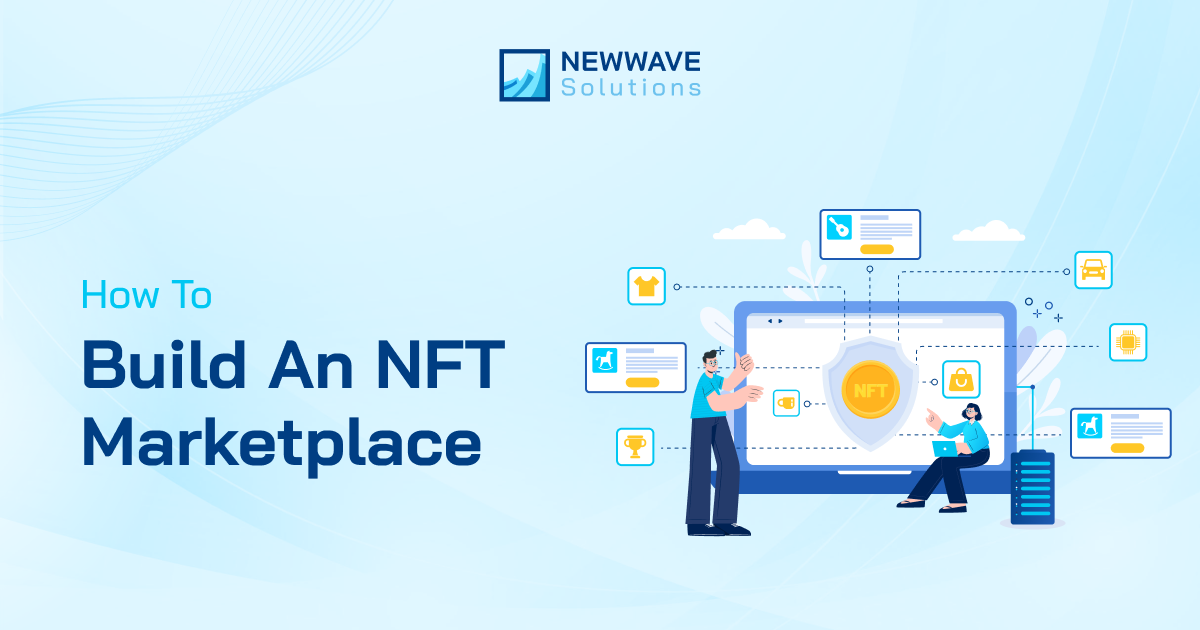
The NFT (non-fungible token) marketplace is a rapidly growing digital landscape where users can buy, sell, and trade unique digital assets. These online platforms serve as hubs for NFT enthusiasts, enabling them to discover, collect, and exchange these prized digital items. For those interested in the NFT marketplace development process, this guide provides a comprehensive overview – from conceptualization to launch.
1. What Is NFT Marketplace Development?
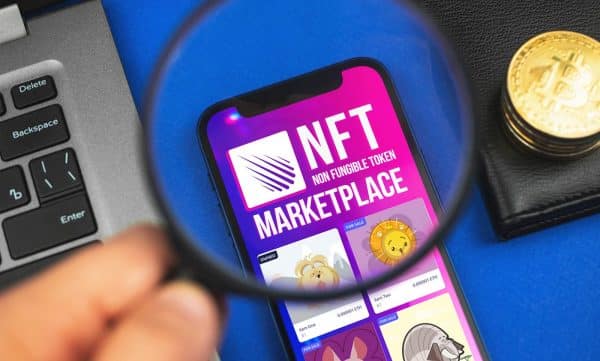
An NFT marketplace is known as a digital platform where users can buy, sell, and trade non-fungible tokens (NFTs). These one-of-a-kind digital assets can represent anything from stunning works of digital art and coveted collectibles to virtual real estate and beyond.
The magic behind NFT marketplaces lies in their secure and transparent environment, powered by blockchain technology. This ensures the authenticity and ownership of these digital assets, fostering trust and facilitating seamless transactions.
Here’s why NFT marketplace development is gaining significant traction:
- Democratization of Digital Ownership: NFT marketplaces empower creators and artists to monetize their digital works, providing them with a new avenue to showcase and sell their creations directly to collectors and enthusiasts.
- Increased Transparency and Security: Blockchain technology underpins NFT marketplaces, offering a secure and transparent system for recording ownership and transactions, reducing the risk of fraud and counterfeiting.
- Emergence of New Asset Classes: NFTs have opened up new possibilities for digital asset ownership, transforming digital items into tradable and collectible assets, which can lead to the development of novel investment opportunities.
- Ecosystem Growth: The success of NFT marketplaces is closely tied to the overall growth of the blockchain and cryptocurrency ecosystem, as they provide a vital infrastructure for the development and adoption of these technologies.
2. 7 Steps To Build NFT Marketplace
This guide provides a step-by-step breakdown of creating an NFT marketplace, from market research to launch. Whether you’re building an NFT marketplace from scratch or looking to create an NFT marketplace using existing solutions, this comprehensive guide will equip you with the knowledge you need.
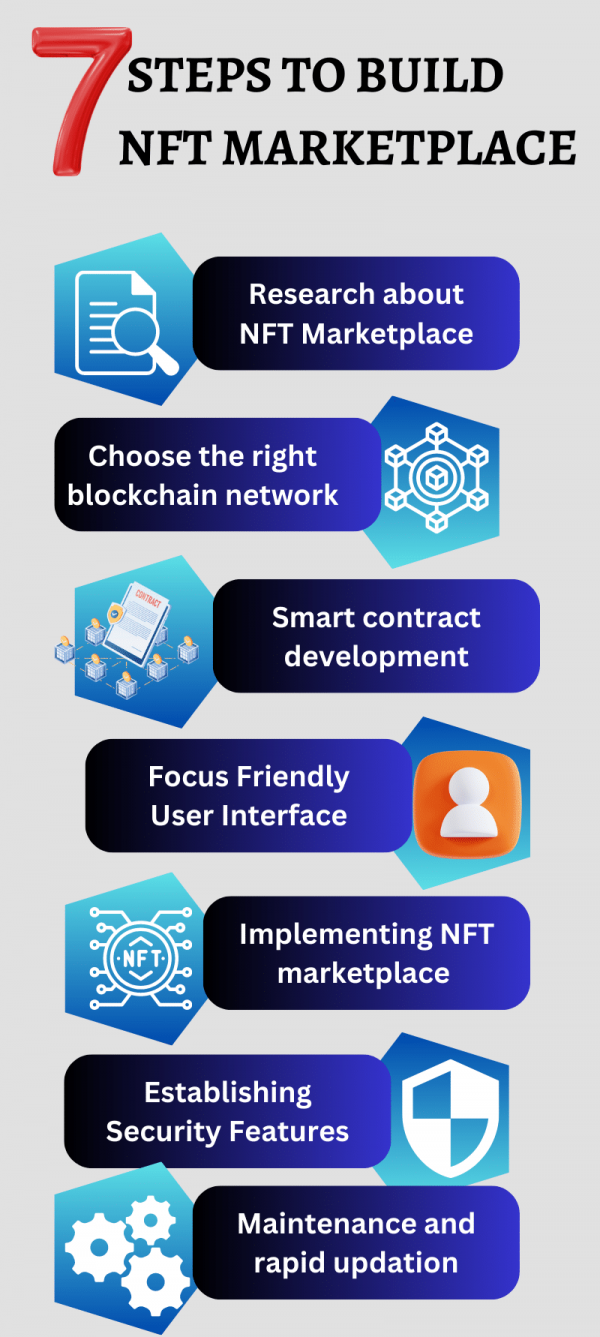
2.1. Market Research and Analysis
Before diving in, it’s crucial to understand the NFT landscape. This initial phase involves thorough market research and analysis to identify your target audience, their needs, and the existing competition. Here’s what you’ll be focusing on:
- Identifying Your Target Market: Who are you building this for? Gamers, artists, or a specific niche?
- Analyzing NFT Trends: What types of NFTs are popular? What problems do current marketplaces have?
- Evaluating Existing Marketplaces: What features do they offer? How can you stand out?
- Defining Your Unique Value Proposition: What makes your marketplace different and appealing?
2.2. Platform Selection and Development Approach
Now that you understand the market, it’s time to choose the foundation for your platform. This phase involves selecting the right blockchain platform and deciding on your development approach. You can have a look at two main factors below:
- Blockchain Selection: Popular options include Ethereum, Solana, Polygon, and Binance Smart Chain. Each offers unique advantages like scalability, transaction speed, and gas fees. Choose the one that best aligns with your marketplace’s needs.
- Development Approach: Will you build an NFT marketplace from scratch for complete control, or leverage a white-label solution for faster deployment? Consider your budget, resources, and desired level of customization.
2.3. Smart Contract Development
Smart contracts are the magic behind NFTs. Smart contract development is crucial for securely managing NFT minting, trading, and ownership on your marketplace. Here’s what the development team will focus on:
- Designing Smart Contract Functionality: This involves defining how NFTs will be minted, traded, and managed within your marketplace.
- Building Core Features: The team will implement logic for NFT minting, trading, and secondary market functionality like royalty payments.
- Security Testing: Rigorous testing is essential to ensure the smart contracts are secure and function as intended.
2.4. User Interface and User Experience Design
A user-friendly platform is key to attracting and retaining users. This phase focuses on designing an intuitive and visually appealing user interface (UI) that provides a seamless user experience (UX). Here’s what the team will accomplish:
- Crafting the User Interface: This involves designing the layout, color scheme, and overall look and feel of your marketplace.
- Building User Navigation: The team will focus on creating intuitive navigation and browsing features for a smooth user experience.
- Integrating NFT Functions: Features like NFT listing, bidding, and purchasing need to be seamlessly integrated into the platform.
- Ensuring Responsiveness: The UI/UX should be responsive and function flawlessly across different devices.
2.5. Integration of Blockchain Technology
For secure and transparent NFT transactions, your marketplace needs to be tightly integrated with the chosen blockchain platform. This phase involves:
- Connecting to the Blockchain: A secure connection between your marketplace and the chosen blockchain needs to be established.
- Integrating Wallets: The team will integrate functionalities for users to connect their crypto wallets for transactions.
- Developing APIs and Middleware: APIs and middleware will facilitate smooth interaction between your platform and the blockchain.
- Ensuring Compatibility: The marketplace should be compatible with existing blockchain tools and protocols.
2.6. Security Measures Implementation
Security is paramount for any NFT marketplace. This phase involves implementing robust security measures to protect user data, assets, and transactions. Here’s what the team will focus on:
- Secure Authentication: Strong authentication and authorization protocols will prevent unauthorized access.
- Anti-Fraud Measures: The team will incorporate functionalities to combat fraud and money laundering activities.
- Secure Storage: Secure storage and access control mechanisms will be implemented to safeguard NFTs.
- Regular Security Audits: Regular security audits and updates are crucial to maintaining a secure platform.
2.7 Maintenance and Rapid Updation
To ensure the smooth functioning and relevance of an NFT marketplace, it is crucial to prioritize maintenance and rapid updation. This involves regular monitoring of the platform for any technical glitches, security vulnerabilities, or performance issues. Additionally, staying abreast of the latest trends and developments in the NFT space is essential for making timely updates to the marketplace.
Implementing a robust maintenance strategy involves conducting routine checks on the platform’s infrastructure, database, and security protocols. This can help in identifying and addressing any potential issues before they escalate. Furthermore, regular updates to the marketplace’s features, user interface, and smart contract functionality can enhance the overall user experience and keep the platform competitive in the market.
Rapid updation also involves responding promptly to user feedback and market demands. This may include integrating new payment methods, adding support for different blockchain networks, or incorporating features that align with evolving NFT standards. By prioritizing maintenance and rapid updation, an NFT marketplace can stay agile and adaptive in a rapidly evolving landscape.
By following these steps and carefully considering each phase, you’ll be well on your way to creating a successful NFT marketplace.
3. How to Build an NFT Marketplace
Building an NFT marketplace opens a gateway to the exciting world of digital ownership and collectibles. But before you dive in, it’s crucial to understand the technical requirements involved. This guide will walk you through the key steps involved in NFT marketplace development, equipping you with the knowledge to build an NFT marketplace that caters to your specific audience.
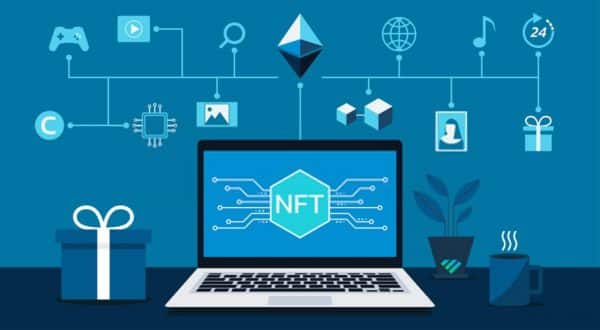
3.1. Understanding the Technical Requirements
A successful NFT marketplace hinges on a solid technical foundation. Here are some key NFT marketplace development requirements to consider:
- Blockchain Platform: Selecting the appropriate blockchain platform (e.g., Ethereum, Solana, Polygon) based on factors like scalability, transaction speed, and gas fees.
- Smart Contract Development: Designing and implementing the smart contracts that govern the NFT minting, trading, and ownership processes.
- Wallet Integration: Integrating the marketplace with popular cryptocurrency wallets to enable secure user authentication and transactions.
- User Interface and APIs: Developing a user-friendly and responsive user interface, as well as the necessary APIs to facilitate blockchain interactions.
- Security and Compliance: Implementing robust security measures and ensuring compliance with relevant regulations and guidelines.
3.2. Choosing the Right Blockchain Platform
The choice of the blockchain platform is a critical decision in the development of an NFT marketplace. Some of the popular blockchain platforms for NFT development include:
| Blockchain Platform |
Key Features |
|
Ethereum |
Established platform with a large ecosystem; supports ERC-721 and ERC-1155 standards |
|
Solana |
High-performance blockchain with fast transaction times and low fees |
| Polygon |
Layer-2 scaling solution for Ethereum, offering lower gas fees and improved scalability |
| Binance Smart Chain |
Ethereum-compatible blockchain with fast transaction times and low fees |
3.3. Smart Contract Development and Implementation
Smart contracts are the magic behind NFTs. These self-executing contracts reside on the blockchain and govern crucial aspects of your marketplace, including:
- Minting unique NFTs: Smart contracts define the process for creating NFTs with specific characteristics and data (metadata) attached.
- Trading and marketplace functionality: This includes features like listing NFTs for sale, bidding on them, purchasing them, and ensuring creators receive royalties on future sales.
- Ownership and transfer: Smart contracts securely manage NFT ownership and enable users to transfer them to others seamlessly.
- Security and error handling: Robust security measures are paramount to prevent vulnerabilities. Well-written smart contracts include error-handling mechanisms to ensure smooth operation.
3.4. Frontend and Backend Development
A user-friendly interface is key to attracting users to your NFT marketplace. Here’s what goes into building a seamless experience:
- Frontend development: This involves designing the user interface (UI) where users can browse NFTs, create listings, participate in auctions, and make purchases.
- Backend development: The backend is the engine that powers your marketplace. It involves building APIs (application programming interfaces) to interact with the blockchain, handle user authentication, and manage marketplace operations.
- Wallet integration: Allowing users to connect their preferred crypto wallets is essential. This enables secure login and facilitates NFT transactions.
- Payment gateway integration: Integrate payment gateways to give users the flexibility to purchase NFTs using fiat currency (like USD) or cryptocurrency.
3.5. Testing and Quality Assurance
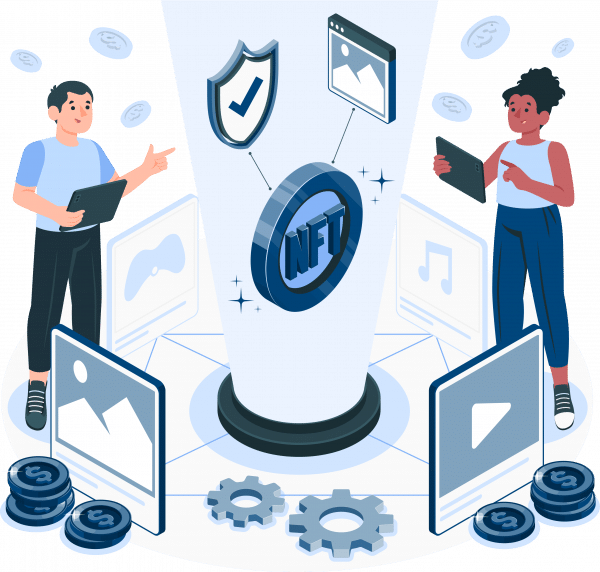
Thorough testing and quality assurance are crucial to ensure the stability, security, and performance of the NFT marketplace. Key activities in this phase include:
- Unit Testing: Testing the individual components and functionalities of the marketplace, including the smart contracts, frontend, and backend.
- Integration Testing: Verifying the seamless integration of the different components, such as blockchain integration, wallet integration, and payment gateway.
- Security Testing: Conducting comprehensive security assessments to identify and address vulnerabilities, such as smart contract audits and penetration testing.
- Performance Testing: Evaluating the platform’s scalability and handling of high-traffic scenarios, ensuring a smooth user experience.
3.6. Deployment and Maintenance
Once you’ve completed development and testing, it’s time to launch your NFT marketplace! Here’s what you need to consider for a successful deployment:
- Deployment: Setting up the necessary infrastructure, such as hosting, content delivery networks, and cloud services, to ensure the reliable and secure operation of the platform.
- Ongoing Maintenance: Implementing a robust maintenance plan, including regular software updates, security patches, and monitoring of the platform’s performance and user activity.
- Community Engagement: Fostering a vibrant community of users, creators, and collectors, and actively engaging with them to gather feedback and continually improve the platform.
- Scalability and Growth: Ensuring the platform’s ability to handle increasing user demand and transaction volumes, and planning for future expansion and feature enhancements.
By following these steps and carefully considering each aspect of NFT marketplace development, you’ll be well on your way to launching a successful platform that caters to your target audience and thrives in the ever-evolving NFT landscape.
4. Crucial Considerations for NFT Marketplace Development
NFT marketplaces like OpenSea or Rarible are online platforms built on blockchain technology. These platforms allow users to create NFT marketplaces (turn digital assets into NFTs), list NFT marketplaces (sell their NFTs), and buy NFT marketplaces (purchase NFTs from other creators).
Throughout this guide, we’ll explore how to create an NFT marketplace on your platform while keeping in mind the needs of both creators and collectors.
4.1. Building a Secure and Compliant Marketplace
The legal landscape surrounding NFTs is still evolving, so it’s crucial to build a platform that adheres to current regulations. Here’s what you need to consider:
- Staying Compliant: Make sure your marketplace follows all relevant laws related to digital assets, securities, anti-money laundering (AML), and know-your-customer (KYC) requirements.
- Protecting Intellectual Property: Implement safeguards to protect the intellectual property of creators and ensure the legitimacy of NFTs traded on your platform.
- Taxation and Reporting: Develop a system for handling tax reporting and compliance for both NFT creators and collectors.
4.2. Ensuring Scalability and Performance
As your NFT marketplace grows, it needs to be able to handle the increasing demand. Here’s how to ensure smooth operation:
- Choosing the Right Blockchain: Select a blockchain platform that can scale to accommodate a high volume of transactions and users. Ethereum is a popular choice, but others like Solana are gaining traction for their scalability.
- Building for Growth: Design your platform’s architecture to allow for future growth. This includes having the ability to scale server resources, storage, and network capacity.
- Optimizing for Speed: Implement optimization techniques like caching, load balancing, and efficient data processing to keep your platform running smoothly.
4.3. Making Payments Seamless
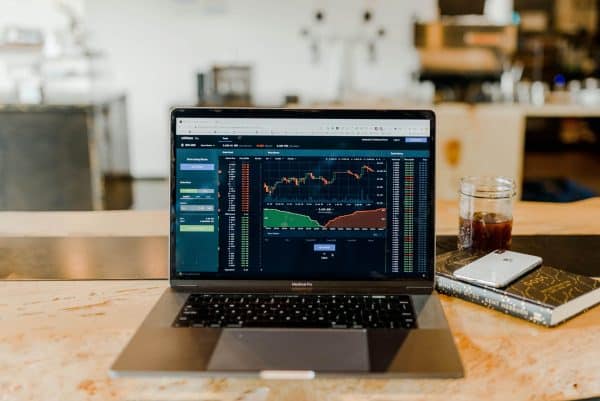
Seamless payment integration is crucial for the success of an NFT marketplace. Key considerations include:
- Cryptocurrency Support: Integrate popular cryptocurrencies like Ethereum, Bitcoin, and Solana to allow users to purchase NFTs with digital assets.
- Fiat Integration: Provide the option to buy NFTs using traditional currencies (fiat) through payment gateways like Stripe or PayPal.
- Secure Transactions: Ensure your payment processing adheres to industry-standard security protocols and complies with relevant financial regulations.
4.4. Building a Thriving Community
A strong community is the lifeblood of an NFT marketplace. Here’s how to foster one:
- Community Engagement: Create a vibrant community of NFT enthusiasts through social media channels, forums, and online events.
- Influencer Partnerships: Collaborate with influential figures in the NFT and blockchain space to spread awareness and attract users.
- Content Marketing: Develop content that educates and engages your target audience. Showcase your platform’s features and the benefits it offers to creators and collectors.
- Targeted Campaigns: Launch targeted marketing campaigns like NFT drops, airdrops, and referral programs to attract new users and drive platform growth.
4.5. Creating a Sustainable Business Model
You’ll need a solid revenue model to ensure your NFT marketplace thrives in the long run. Here are some options to consider:
- Transaction Fees: Charge a commission fee on each NFT transaction, either from the buyer, the seller, or both.
- Listing Fees: Implement a fee structure for creators to list their NFTs on your platform.
- Subscription Model: Offer tiered subscriptions with premium features or services for a recurring fee.
- Advertising and Sponsorships: Generate revenue through advertising placements, sponsored content, or exclusive NFT drops with partner brands.
By considering these factors and tailoring them to your unique vision, you’ll be well on your way to developing a successful NFT marketplace that caters to the needs of both creators and collectors in the ever-evolving NFT landscape.
5. Challenges in Building an NFT Marketplace Development
Developing a successful NFT marketplace comes with its own set of hurdles. Let’s dive into some of the key challenges you might face while creating an NFT marketplace and how to approach them:
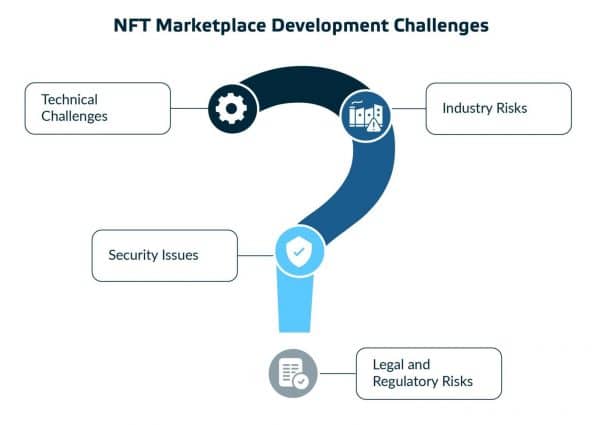
5.1. Building Trust in Your NFT Marketplace
Security is paramount when it comes to NFTs and cryptocurrencies. Here’s what to keep in mind:
- Smart Contract Vulnerabilities: Smart contracts are the backbone of NFT marketplaces. How to create an NFT marketplace securely involves ensuring these contracts are written with robust code and thoroughly audited to eliminate weaknesses that could be exploited by hackers.
- Wallet Integration Security: When users connect their crypto wallets to your platform, their funds are at stake. Implement strong security measures like secure authentication, encryption, and access controls during NFT marketplace development.
- Fraud and Theft Prevention: Unfortunately, some users might try to exploit your platform. Consider incorporating mechanisms to detect and prevent fraudulent activities such as wash trading (artificially inflating prices), bid sniping (placing bids at the last second), and NFT theft.
5.2. Keeping Up with Growth
As the NFT market expands, your platform needs to be able to handle the increase in users and transactions. Here’s how to ensure scalability during NFT marketplace development:
- Blockchain Scalability: The chosen blockchain network needs to be able to handle a high volume of transactions without slowing down. Research different blockchains like Ethereum, Solana, or Polygon, considering their transaction fees and processing speeds to find the best fit for your build NFT marketplace project.
- Infrastructure Scaling: Design your platform’s architecture to accommodate growth. This includes using cloud-based solutions and building a modular system that can be easily scaled up as needed.
- Performance Optimization: Even with a large user base, your platform should remain responsive. Implement optimization techniques to ensure a smooth user experience during peak activity.
5.3. Navigating the Evolving Landscape
The regulatory landscape for NFTs and blockchain-based platforms is constantly evolving, presenting significant challenges for NFT marketplace development. Key regulatory-related concerns include:
- Compliance with Existing Laws and Regulations: Stay updated on the latest laws governing digital assets, securities, and financial transactions. This is crucial during NFT marketplace development.
- Uncertainty and Ambiguity: Navigating the uncertainty surrounding the legal classification and treatment of NFTs, as regulatory bodies continue to develop guidelines and policies.
- Jurisdictional Differences: Addressing the varying legal and regulatory requirements across different regions and countries where the NFT marketplace operates.
5.4. User Adoption and Education
Encouraging users to adopt your platform and understand NFTs is essential. Here’s how to approach this challenge:
- Onboarding and User Experience: Creating a new NFT marketplace? Make the onboarding process for both creators and collectors as smooth and intuitive as possible. Minimize technical barriers to entry.
- User Education: Provide educational resources, tutorials, and strong support channels. Help users understand the concepts of NFTs, blockchain technology, and how your marketplace functions.
- Mainstream Adoption: Move beyond the niche market. Help people see the value proposition of NFTs and how they can participate in this growing space.
6. Conclusion
The rapid growth of the blockchain ecosystem has made NFT marketplace development a crucial focus. These marketplaces provide a secure and transparent platform for buying, selling, and trading unique digital assets, transforming the concept of digital ownership and creativity.
As the demand for NFTs increases, it is essential to develop robust and user-friendly NFT marketplaces. This can address technical, regulatory, and user-centric challenges, fostering innovation, empowering creators, and enabling new investment opportunities.
Newwave Solutions, a leading software development company in Vietnam, offers expertise in custom blockchain development, including NFT marketplace creation. With over 12 years of experience and a team of 300+ skilled professionals, Newwave Solutions is your trusted partner for revolutionizing your blockchain initiatives.
Connect with Newwave Solutions today to explore how we can help you build a successful and sustainable NFT marketplace.
Contact Information:
- Head Office (Hanoi): 1F, 4F, 10F, Mitec Building, Duong Dinh Nghe Street, Yen Hoa Ward, Cau Giay District, Hanoi City, Vietnam
- Branch Office (Tokyo): 1chōme118 Yushima, Bunkyo City, Tokyo 1130034, Japan
- Hotline: +84 985310203
- Website: https://newwavesolution.com
- Email: [email protected]
To Quang Duy is the CEO of Newwave Solutions, a leading Vietnamese software company. He is recognized as a standout technology consultant. Connect with him on LinkedIn and Twitter.

Read More Guides
Get stories in your inbox twice a month.
Let’s Connect
Let us know what you need, and out professionals will collaborate with you to find a solution that enables growth.


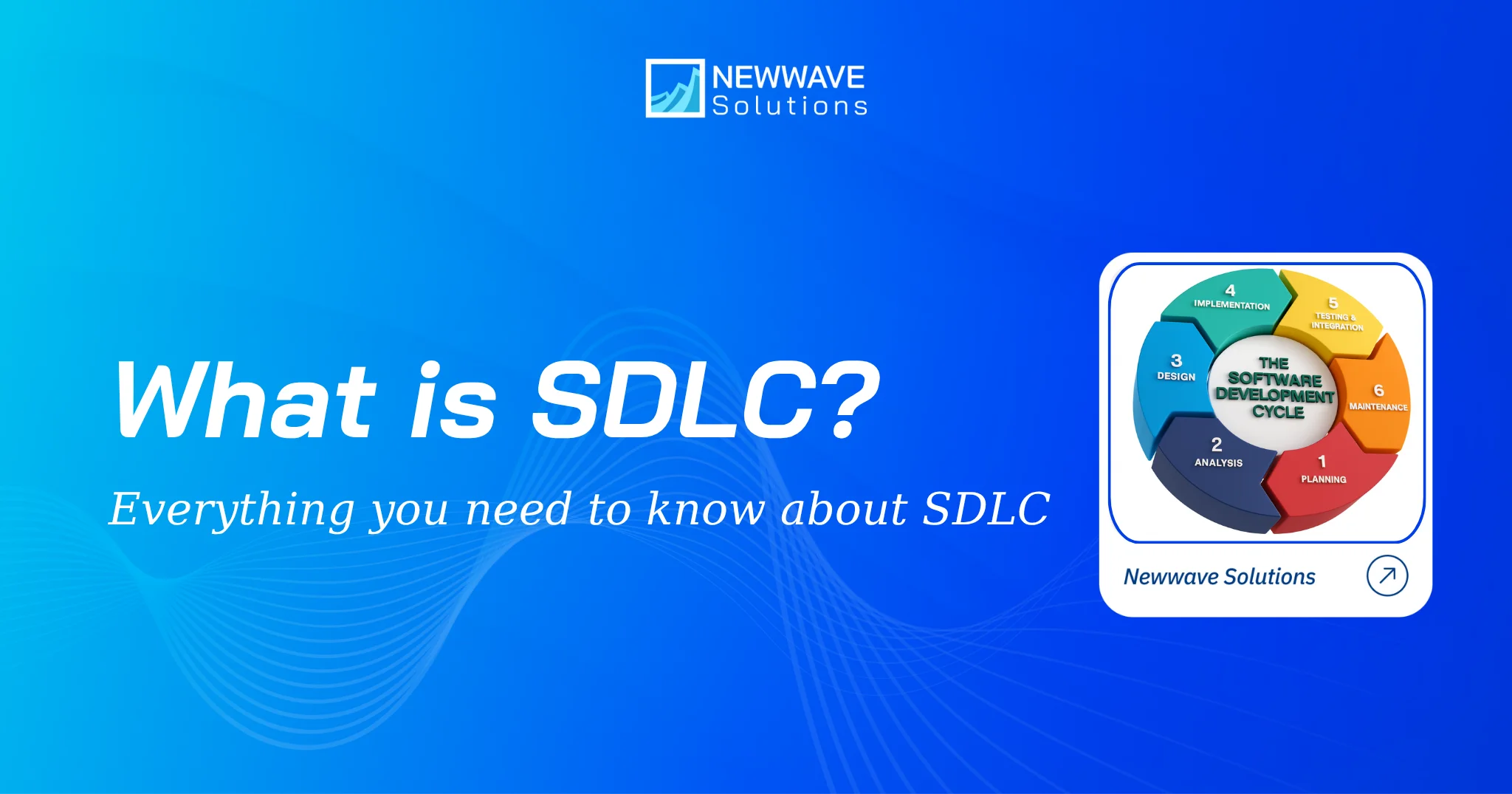
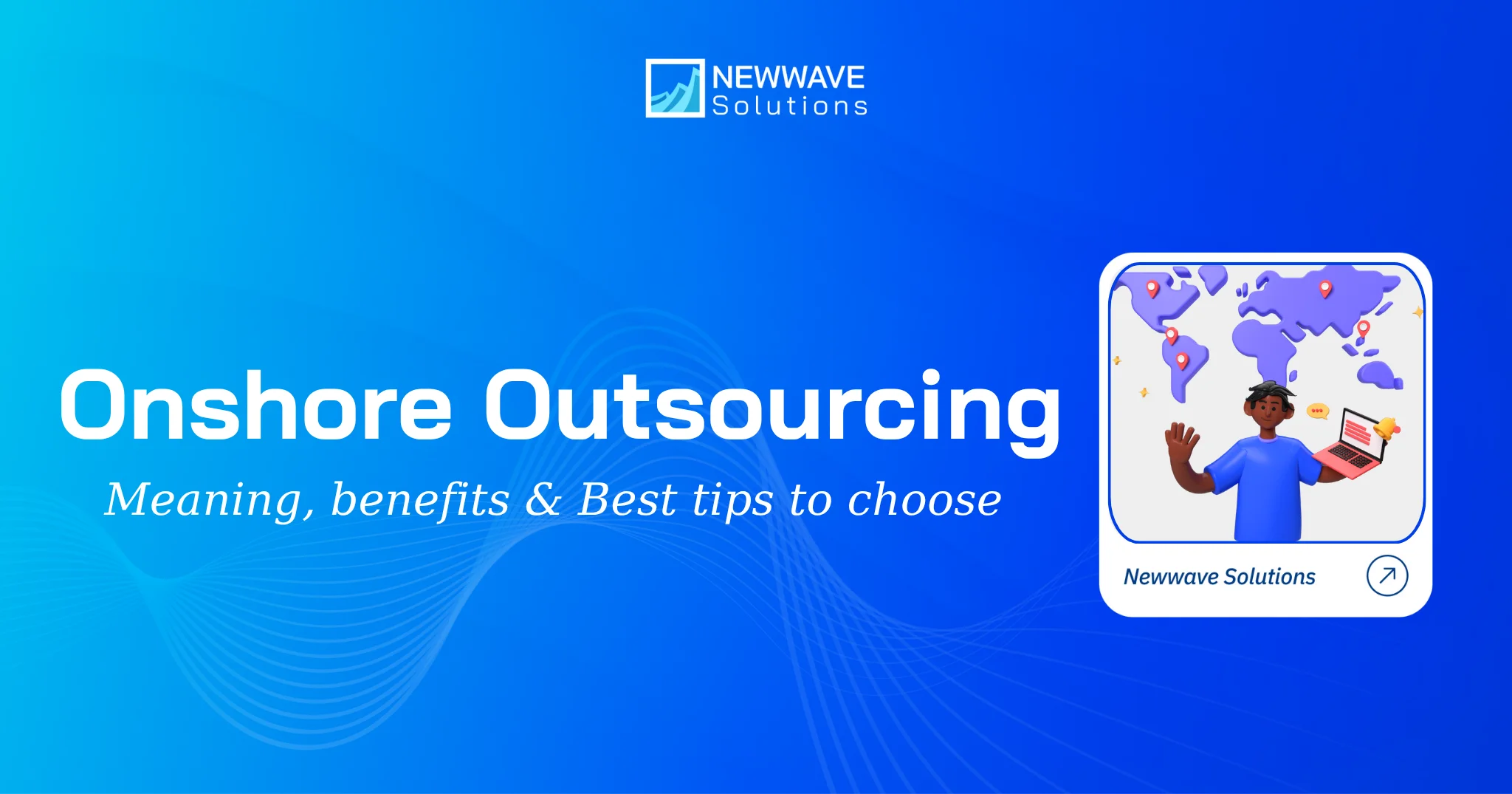
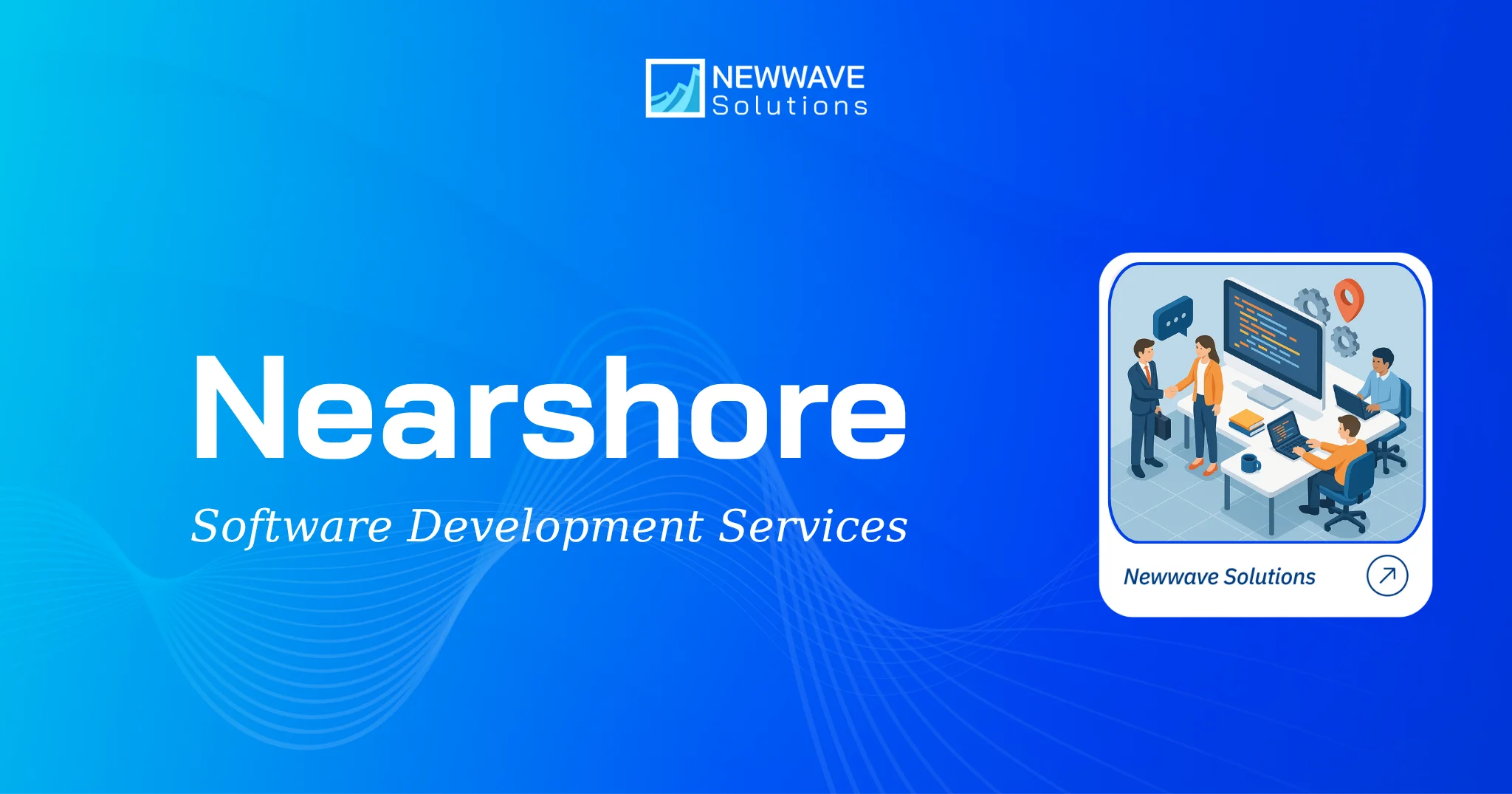
Leave a Reply